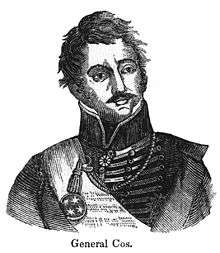Martín Perfecto de Cos
| Martín Perfecto de Cos | |
|---|---|
 Martin | |
| Personal details | |
| Born |
1800 Veracruz, Veracruz, New Spain |
| Died |
1854 (aged 53–54) Minatitlán, Veracruz |
| Nationality | Mexican |
| Profession | Military General |
Martín Perfecto de Cos (1800–1854) was a 19th-century Mexican general. He was born in Veracruz, the son of an attorney. He became an army cadet at the age of 20. He died in Minatitlán, Vera Cruz, on October 1, 1854, while serving as commandant general and political chief of the Tehuantepec territory.
Personal
It is generally accepted that Cos was a relative of Generalissimo Antonio López de Santa Anna, and most accounts refer to him as a brother-in-law.[1] Some early Texas accounts also credit him as being either a cousin or nephew of Santa Anna.[2] The Encyclopedia of the Mexican American War states that he was married to Lucinda López de Santa Anna, the general's sister.[3]
Military career

When the Mexican government moved away from a local-level governance Federalist political ideology to creating a Centralist authoritarian government under Santa Anna, Cos became military commander the Mexican state of Coahuila y Tejas (Coahuila and Texas) in 1833. He initially was headquartered in Saltillo. San Antonio had always governed its own affairs and its citizens resented Cos being given power over them.[4] As tensions between Mexico City and Texas increased, Cos headed north to put down the rebellion.[5]
Cos arrived in Texas on September 21, 1835 with 300 soldiers. and proceeded to the town of Goliad on October 1, before moving on to San Antonio de Béxar. He ordered the arrest of rebel leaders. Once he was in San Antonio (Siege of Béxar), Cos was assailed by Texan forces under the leadership of Stephen F. Austin. The town was put under siege by the Texan army. After a 56-day siege of the town and Alamo mission, on December 9, Cos surrendered the town of San Antonio and weapons to the Texans,then proceeded to leave Texas. Cos and his men were allowed their muskets for protection and one four-pound cannon. Mexican losses during the siege were about 150. On his way south, Cos met up with Santa Anna's forces at Laredo marching north to put down the rebellion.[6][7]
Cos returned to San Antonio and led a column of 300 soldiers against the northwest corner of the Alamo on March 6, 1836. Eventually Cos' soldiers overran the Alamo's north wall. On April 21, 1836, Cos arrived with over five hundred reinforcements for Santa Anna shortly before the Battle of San Jacinto.[8][9] That afternoon Texan forces led by General Sam Houston defeated General Santa Anna's army in a decisive victory in a battle which lasted only eighteen minutes. Generals Cos and Santa Anna both escaped during the battle; Santa Anna was captured the next day on April 22 and Cos was captured on April 24, 1836[10]. General Santa Anna subsequently surrendered his army and eventually all claim to Texas.[11]
Mexican-American War (1846–1848)
After Battle of San Jacinto, Cos remained in the Mexican Army and was given command of an army outpost in Tuxpan where he served until his death in 1854.[3]
Film depiction
Among the depictions of Cos on film is that of the Mexico City-born actor Rodolfo Hoyos, Jr., in the 1956 picture, The First Texan, about the rise of Sam Houston in Texas. In the film, Cos orders the arrest of William B. Travis and directed his Mexican soldiers to scale successfully the walls of The Alamo.[12]
In the 2004 film The Alamo, Fransisco Philibert depicts General de Cos.[13]
References
- ↑ Biographical Encyclopedia of Texas. New York: Southern Publishing Company. 1880. pp. 276–277.
- ↑ Jackson & Wheat 2005, p. 201.
- 1 2 Tucker, Arnold & Wiener 2013, p. 176.
- ↑ Ramos 2008, p. 139.
- ↑ Ramos 2008, p. 144.
- ↑ Roell 2013, pp. 40–50.
- ↑ Hazelwood, Claudie (12 June 2010). "Martin Perfecto de Cos". Handbook of Texas Online. Texas State Historical Association. Retrieved 20 July 2017.
- ↑ Flores 2002, pp. 26–28.
- ↑ Nofi 1994, p. 203.
- ↑ General Samuel Houston, Report of HQ, Texian Army, published in Daily National Intelligencer, Jun 11, 1836, Vol. XXIV, Issue 7280, p.2, Washington, DC
- ↑ Fowler 2007, pp. 171, 173.
- ↑ "The First Texan". Internet Movie Data Base. Retrieved February 12, 2014.
- ↑ "Francisco Philibert". www.rottentomatoes.com. Retrieved July 21, 2017.
Bibliography
- Flores, Richard R. (2002). Remembering the Alamo: Memory, Modernity, and the Master Symbol. University of Texas Press. ISBN 978-0-292-79647-8 – via Project MUSE. (Subscription required (help)).
- Fowler, Will (2007). Santa Anna of Mexico. University of Nebraska Press. ISBN 978-0-8032-5646-0 – via Project MUSE. (Subscription required (help)).
- Jackson, Jack; Wheat, John (2005). Almonte's Texas: Juan N. Almonte's 1834 Inspection, Secret Report & Role in the 1836 Campaign. Denton, TX: Texas State Historical Association. ISBN 978-0-87611-207-6.
- Nofi, Albert A. (1994). The Alamo and the Texas War of Independence, September 30, 1835 to April 21, 1836: Heroes, Myths, and History. New York: De Capo Press. ISBN 0-306-80563-4 – via Questia Online Library. (Subscription required (help)).
- Ramos, Raúl A. (2008). Beyond the Alamo: Forging Mexican Ethnicity in San Antonio, 1821–1861. The University of North Carolina Press. ISBN 978-1-4696-0465-7 – via Project MUSE. (Subscription required (help)).
- Roell, Craig H. (2013). Matamoros and the Texas Revolution. Texas State Historical Association. ISBN 978-0-87611-266-3 – via Project MUSE. (Subscription required (help)).
- Tucker, Spencer; Arnold, James R.; Wiener, Roberta (2013). The Encyclopedia of the Mexican-American War: A Political, Social, and Military History. ABC-CLIO. ISBN 978-1-85109-853-8.